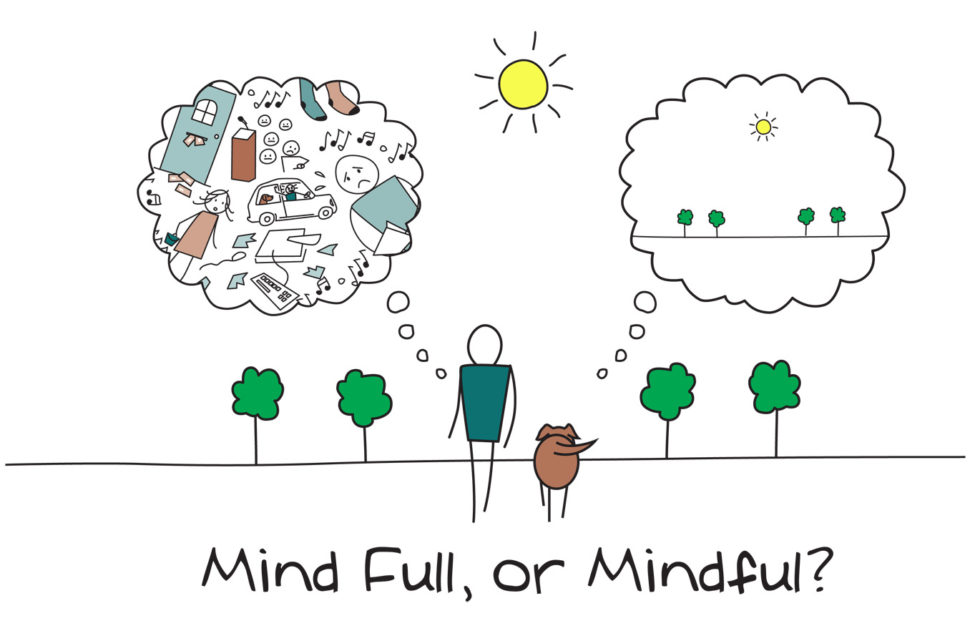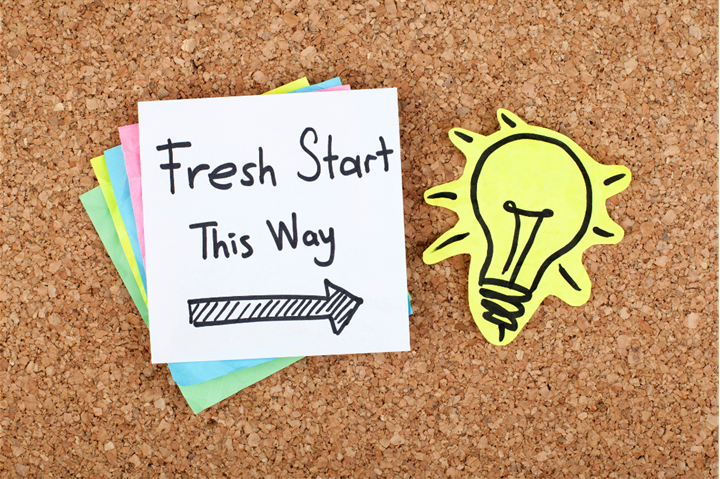
by Guest | Jan 19, 2022 | Being Well
Hoping to slow down and embrace living in the moment this year? After another unsettling year, many of us are looking to regroup and find a “new normal” as we enter into the new year. Dedicating a few minutes a day to mindfulness can help reduce stress, increase calmness and clarity, and promote happiness – and who couldn’t use a little more of that in 2022?
Too often, we find ourselves in a frenzied, unhappy and unsettled state-of-mind. Many people simply feel there are not enough hours in a day. Cultural norms tell us that multitasking is good, that “busy-ness” is both normal and noble. People are told to learn to say “no” but find it difficult because everything seems to be of equal and vital importance.
This constant state of activity and worry places a heavy toll on both the mind and the body. It can contribute to anxiety, depression, addiction and damaged relationships. An overloaded nervous system, in a constant state of fight-or-flight, produces chronic stress that has far-reaching effects.
Enter Mindful-Based Stress Reduction. Through a regular practice of cultivating awareness of experiences and sensations and learning to view them without judgement, things begin to fall into place. Priorities shift and emerge. Our sensory system remains calm amidst a stressful day. We experience life with a sense of clarity and objectivity.
We can only change something if we know what the root of the problem is. A mindfulness practice strips away every voice – including our own. We become an interested observer of what is happening in the body and the mind. It is like watching a movie with flashbacks and foreshadowing. We are “let in” on the back story that explains the characters’ behavior.
The practice itself can be as simple as spending five minutes each day, sitting quietly, breathing deeply and simply being present with acceptance. We accept who we are, where we are, just as we are in that exact moment. Thoughts may come and go and that’s okay. Often, they provide clues as to the source of our anxiety, past hurts, and frustrations. Rather than stuff them or block them, we allow these thoughts and feelings to appear. We greet them at the door but we don’t invite them to stay.
While a regular, defined practice is ideal, we can incorporate mindfulness into everyday activities. We can catch ourselves reacting to a situation and tune into it through our mindfulness viewer. Research shows that awareness in and of itself is enough to alter patterns of behavior. It takes on a snowball effect. The more we catch ourselves, the more quickly we hit the reset button until the brain recognizes the situation as non-threatening and resets itself. It is important to remember that, when we catch ourselves in an unhealthy habit, we do not attach any negative self-criticism. Acceptance without judgement is key. Setting an intention for healthier behaviors and self-healing are equally important.
As with any new task, the more often we practice the new habit, the more automatic it becomes. And just like building our muscles or mental focus, regular practice creates a new default. Two important benefits of a mindfulness practice are nonreactivity and self-regulation. Without expressly working to develop them, these two traits emerge. We often only realize it when we catch ourselves remaining calm in a situation that would have generated fear or anger before.
Mind-body classes such as Qigong, Tai Chi and Yoga include a component of mindfulness. Locally, class schedules can be found at the Tillamook Family YMCA or in the Tillamook Bay Community College course catalog under the community education, Fitness & Health section.
To learn more, check out the New York Times “How to Meditate” for mindfulness and meditation basics, at-home exercises, and strategies for any challenges you may face. If you are looking for guided mindfulness videos, there are many worth exploring online. Try checking out the “Goodful” page on YouTube for meditations, or look for the “Calm” or “Headspace” pages on YouTube, the app store, and streaming platforms (you can find “Headspace Unwind Your Mind” on Netflix or “A World of Calm” on HBO Max).
AUTHOR: Tillamook County Wellness
For more local health and wellness information, follow Tillamook County Wellness on Facebook, Instagram and Twitter.

by Guest | Jan 12, 2022 | Being Well
Every day we hear the results of another study, telling us what is making us unhealthy. Eat this, don’t eat that. Move like this, not like that. It can be overwhelming to figure out what to prioritize or even where to begin.
Awareness. This is where it all starts. We see things more clearly when we take a step back and give them our undivided attention. Take a few moments each day to breathe. Just be. Relax. In doing so, the busyness of the world, the noise of our self-talk, the daily to do list, they all disappear and we are simply left with ourselves and the truth. Layers of thought, emotion, and even traumatic events are often responsible for the “dis-ease” that causes disease. Without going through this process, it may not matter what changes we make to our nutrition or exercise habits. Our bodies seek balance. This applies to our emotional state as well. When we are out of balance, there are a whole host of physiological processes that go off-line as well.
Unfortunately, the typical American lifestyle does not lend itself to mind-body balance. Change is hard. Crazy hard. It’s really inconvenient. It is human nature to take the path of least resistance. It takes time and effort to change the way we live our lives. For most of us, this is where we end up – in a state of knowing we need to do something but not believing that we can really do anything about it. To be successful, we need to make the changes to our habits small, easy-to-adopt, and enjoyable.
Tips for Successful Behavior Change
Why we want to make changes is almost as important as what we want to change. The “why” often determines our chances for success. If we are making a change for our spouse or boss, or as a quick fix (think high school reunion), we might not be as emotionally invested as we need to be successful over the long term. You need to have good reasons to make any lasting change. Maybe it is to be around to see your kids or grandkids grow up or maybe it is about improving your quality of life. Whatever it is, it needs to be meaningful to you.
Setting SMART goals is key to successful behavior change. SMART is an acronym for research-based characteristics that significantly increase the likelihood of reaching one’s goals. They should be:
- Specific
- Measurable
- Attainable
- Relevant
- Time-Bound
For example, if I want to walk 2 miles a day but am currently completely sedentary, I need to break down my goal into manageable pieces. I also need to be realistic. How far can I, and more importantly, will I, walk each day. Maybe it is just a daily walk to my mailbox for the first week. Then, I can walk to the end of the block, then 3 blocks, and so on until I have achieved my goal. It is important to set a time frame for each level of goal attainment. This can be daily or weekly. It needs to be short enough to generate immediate success but also long enough to form a new habit as a foundation for the next step and that usually takes about 8-10 weeks.
Work with your strengths and interests when approaching changes. If you like to cook, then it makes sense to find healthy recipes you would enjoy making. If you hate cooking, it will be important to simplify what nutrition changes you are making so that you can still be successful. It can be as simple as choosing the prepared veggie tray and a container of hummus from the grocery store. This principle is especially important when it comes to physical activity. If you enjoy being outdoors, consider walking or hiking. If you like people, music or dancing, you could join a group fitness class. If you want something more mindful, try Tai Chi, Qigong or Yoga. The key is to look for ways to integrate a positive, healthy change with your personality, interests and strengths.
One of the reasons people struggle with behavior change is because they have been unsuccessful in the past. Three common reasons for this are 1) Setting unrealistic goals 2) Giving up after the first setback, or 3) Taking on too many changes at once.
To avoid these, it is important to set a narrow list of ridiculously small goals. This allows us to celebrate mini victories which perpetuate future successes. BJ Fogg, a researcher at Stanford University, recommends starting with what he calls “Tiny Habits.” He uses an example for someone who wants to develop the habit of flossing their teeth. He suggests flossing one tooth each night after brushing your teeth. Just one tooth. A small, simple act is perceived as more doable and we may be more likely to persist and build on that activity. This is a very real characteristic of human nature and it explains a lot when it comes to why behavior change is so difficult.
To summarize, there are some tricks to successful behavior change:
- Become aware of what you want to change and why
- Set SMART goals
- Make changes that fit your personality, strengths and values
- Start small (REALLY small) and build on your successes
AUTHOR: Michelle Jenck, M.Ed., Community Well-Being Director, Adventist Health Tillamook
For more local health and wellness information, follow Tillamook County Wellness on Facebook, Instagram and Twitter.

by Guest | Jan 5, 2022 | Being Well
As we step into a new year, many of us may be reflecting on different aspects of our lives. Although many of us might think of New Year’s resolutions such as eating more veggies or trying out a gym membership, taking a moment to look at our personal relationships and where our individual happiness lies is just as important in terms of our overall well-being. Tides of Change, a local advocacy organization, provides an overview of how our relationships can function to both positively and negatively impact our health – and offers information around how to access free, confidential services for anyone who might need support in any stage of a relationship, both past and present:
Did you know your relationship affects your health? All types of relationships, negative and positive, both past and present affect your health. Relationships with your friends, your family, the person you are dating or with your partner all affect your health.
Healthy relationships promote overall health and well-being, lead to better physical and mental health outcomes and a longer life. Unsurprisingly, unhealthy and abusive relationships contribute to poor health in a variety of ways. Relationships change over time, so a relationship that starts out fun and exciting may not stay that way.
Unhealthy relationships where one person in the relationship uses a variety of methods to gain and maintain power and control over the other person are, unfortunately, common. According to surveys from the National Domestic Violence Hotline, approximately 1 in 4 women and 1 in 7 men have experienced intimate partner violence (IPV). It occurs across every demographic line of socioeconomic status, education level, sexual orientation, race, and religion. It can happen to anyone. IPV is a cycle that generally gets worse over time—not a one-time incident. People who choose abusive behavior use jealousy, isolation, emotional and psychological abuse, coercion, intimidation, shame and threats.
Many people assume that abusive relationships are defined by the presence of physical violence, but research shows that emotional and psychological abuse are used long before any physical violence occurs. Over time, the control tactics cause chronic, toxic stress for the person subjected to them. In terms of health impacts, psychological abuse is as important an indicator for health outcomes as physical abuse. This means a person can experience negative health consequences as a result of an unhealthy relationship without ever being physically hurt by their partner. Unhealthy, abusive relationships affect a person’s immediate and long-term health–reproductive, physical, mental and behavioral health are all potentially impacted in abusive and controlling relationships.
If you are choosing to use power and control and abusive tactics in your relationships and would like to choose differently, please contact Choices Domestic Violence Intervention Program at (503) 530-8927 or at https://www.choicesdvip.com for more information.
Successfully managing mental or physical health conditions while in an unhealthy relationship can be particularly challenging. Controlling, abusive behavior harms the partner who is subjected to it, and can also harm the health and wellbeing of children growing up in homes where abuse is the norm. The Adverse Childhood Experience Study, or ACEs, demonstrated the connection between growing up with violence in the home and experiencing long term chronic health conditions as well as behavioral and mental health conditions later in life. As with childhood ACEs, experiencing abuse can contribute to things like anxiety and depression as well as common chronic illnesses such as high cholesterol, heart disease, diabetes, and chronic pain symptoms even after the unhealthy relationship has ended.
If you or someone you know are concerned that your relationship is affecting your health, there is hope for healing. At Tides of Change (ToC), we believe everyone deserves a healthy and supportive relationship. ToC serves people of all genders with free, confidential advocacy services and ongoing resiliency and support groups. Our services and our 24-hour helpline are available to anyone who has questions about their relationship and about what resources are available to them. ToC provides services for all stages of healing, both for present and past experiences. Tides of Change is located at 1902 2nd St, Tillamook, OR 97141. You can connect with us by calling 503-842-9486 or at www.tidesofchangenw.org . You are not alone, ToC is here to support you.
AUTHOR: Tides of Change
For more local health and wellness information, follow Tillamook County Wellness on Facebook, Instagram and Twitter.



